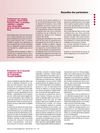Search
for
Sort by
Research
60-90 / 1000+ results
research Development and Validation of a Reversed-Phase HPLC Method for Simultaneous Determination of Doxazosin Mesylate and Finasteride
Created method to measure doxazosin mesylate and finasteride together.

research A 3D Microtumour System That Faithfully Represents Ovarian Cancer Minimal Residual Disease
The study developed a 3D model that closely imitates remaining ovarian cancer after treatment and identified a potential drug targeting resistant cancer cells.

research Extra Facial Aesthetic Indications of Botulinum Toxin: A Review
Botulinum toxin is used for neck, shoulder, calf, and ankle slimming, and hair loss treatment, but can cause muscle weakness and atrophy with regular use.

research Abstract 80
Different levels of shear stress affect where cells move and gather in a 3D-printed model, helping to better understand cell behavior in blood vessels.
research Binding Interactions of Keratin-Based Hair Fiber Extract to Gold, Keratin, and BMP-2
Keratin from hair binds well to gold and BMP-2, useful for bone repair.

research Mental, Behavioral, and Physical Effects of Power-Enhancing Drugs in Chronic Users
Power-enhancing drugs can cause mood swings, aggression, anxiety, and physical side effects, questioning their overall benefits.

research Fabrication of Silver Nanoparticles from Ziziphus Nummularia Fruit Extract: Effect on Hair Growth Rate and Activity Against Selected Bacterial and Fungal Strains
Silver nanoparticles made from Ziziphus nummularia fruit extract promote hair growth and fight bacteria and fungi.

research Author's Reply
Dr. Walter P. Unger believes lasers could eventually be important in hair transplantation for achieving natural-looking results, despite current limitations.

research Insulin Pump Therapy: Accu-Chek FlexLink Plus, The First Self-Retracting Needle Catheter and Accu-Chek LinkAssist Plus
The Accu-Chek FlexLink Plus and Accu-Chek LinkAssist Plus make insulin pump use safer, simpler, and more comfortable.

research Efficient Editing of CSLD2 Orthologue by CRISPR/Cas9 Affects Cell Morphogenesis of Root Hair in Spinach
CRISPR/Cas9 editing in spinach affects root hair growth by altering specific genes.

research Lichen Planopilaris With Foreign-Body Granuloma
Foreign-body granuloma may be a marker for late-stage Lichen Planopilaris and should be considered in diagnosis.

research Estrogenic Potential of 2-Alkyl-4-(Thio)Chromenone 6-O-Sulfamates: Potent Inhibitors of Human Steroid Sulfatase
A substance called Compound 2g can strongly block STS (a hormone-related enzyme) without affecting estrogen levels, making it potentially good for treating breast cancer.
research 26-Year-Old Man With New Abdominal Pain
A gluten-free diet fixed a man's severe stomach pain and bowel issue related to celiac disease, but not much his hair loss.

research 2-Substituted 4-(Thio)chromenone 6-O-Sulfamates: Potent Inhibitors of Human Steroid Sulfatase
New compounds were made that block an enzyme linked to breast cancer better than existing treatments.

research The Ludwig Pattern of Androgenetic Alopecia Is Due to a Hierarchy of Androgen Sensitivity Within Follicular Units That Leads to Selective Miniaturization and a Reduction in the Number of Terminal Hairs Per Follicular Unit
Ludwig pattern hair loss in women results from varying sensitivity in hair follicles, causing fewer visible hairs.

research The Genetics of Hair Shaft Disorders
The article explains the genetic causes and symptoms of various hair disorders and highlights the need for more research to find treatments.

research Hair Health and Management of Common Hair Disorders
Using the right hair care products can improve hair health and help manage hair disorders.

research Organization and Expression of Hair Follicle Genes
Hair growth is controlled by specific gene clusters and proteins, and cysteine affects hair gene expression in sheep.

research Azasteroids as Inhibitors of Testosterone 5α-Reductase in Mammalian Skin
Certain 4-azasteroids are effective at blocking the enzyme that processes testosterone in human skin and could help treat acne, excessive hair growth, and male pattern baldness.
research Bioactive-Based Cosmeceuticals: An Update on Emerging Trends
Natural ingredients in cosmeceuticals are beneficial for skin and hair health with few side effects.

research Jaw Wiring in Treatment of Obesity
Jaw wiring helps with weight loss but long-term habits are needed to keep it off.

research Simultaneous Quantitative Analysis of Tamsulosin and Finasteride in Pharmaceutical Dosage Form by U-HPLC Tandem Mass Spectrometry
Method measures tamsulosin and finasteride in medicine accurately.

research Clinical Hair Loss: Diagnosis and Treatment
The review suggests limited treatments for common hair loss conditions, with potential for future improvements.

research Extensive Scalp Lifting: Decrease in Complications Utilizing Unilateral Occipital Artery Ligation and Other Modifications
The conclusion is that modifying scalp lifting surgery by cutting one occipital artery and making other changes reduces complications and improves outcomes for patients with severe hair loss.

research Residents’ Corner: Multiple Pyogenic Granuloma-like Lesions Following Hair Transplantation
A man developed unusual growths after a hair transplant, which were treated successfully with no recurrence after a month.

research Hair Transplantation in Women: A Practical New Classification System and Review of Technique
A new hair loss classification for women improves treatment, but careful patient selection is crucial for successful hair transplantation.

research Rational Investigations in the Diagnosis and Management of Women with Hirsutism or Androgenetic Alopecia
Diagnose and manage hair issues in women by checking medical conditions and using personalized treatments.

research Enhanced Topical Delivery of Finasteride Using Glyceryl Monooleate-Based Liquid Crystalline Nanoparticles Stabilized by Cremophor Surfactants
Improved hair loss treatment using special particles and surfactants.

research Simultaneous Determination of Finasteride and Tamsulosin in Combined Dosage Form by Using RP-HPLC Method
Method accurately measures finasteride and tamsulosin in combined drug form.